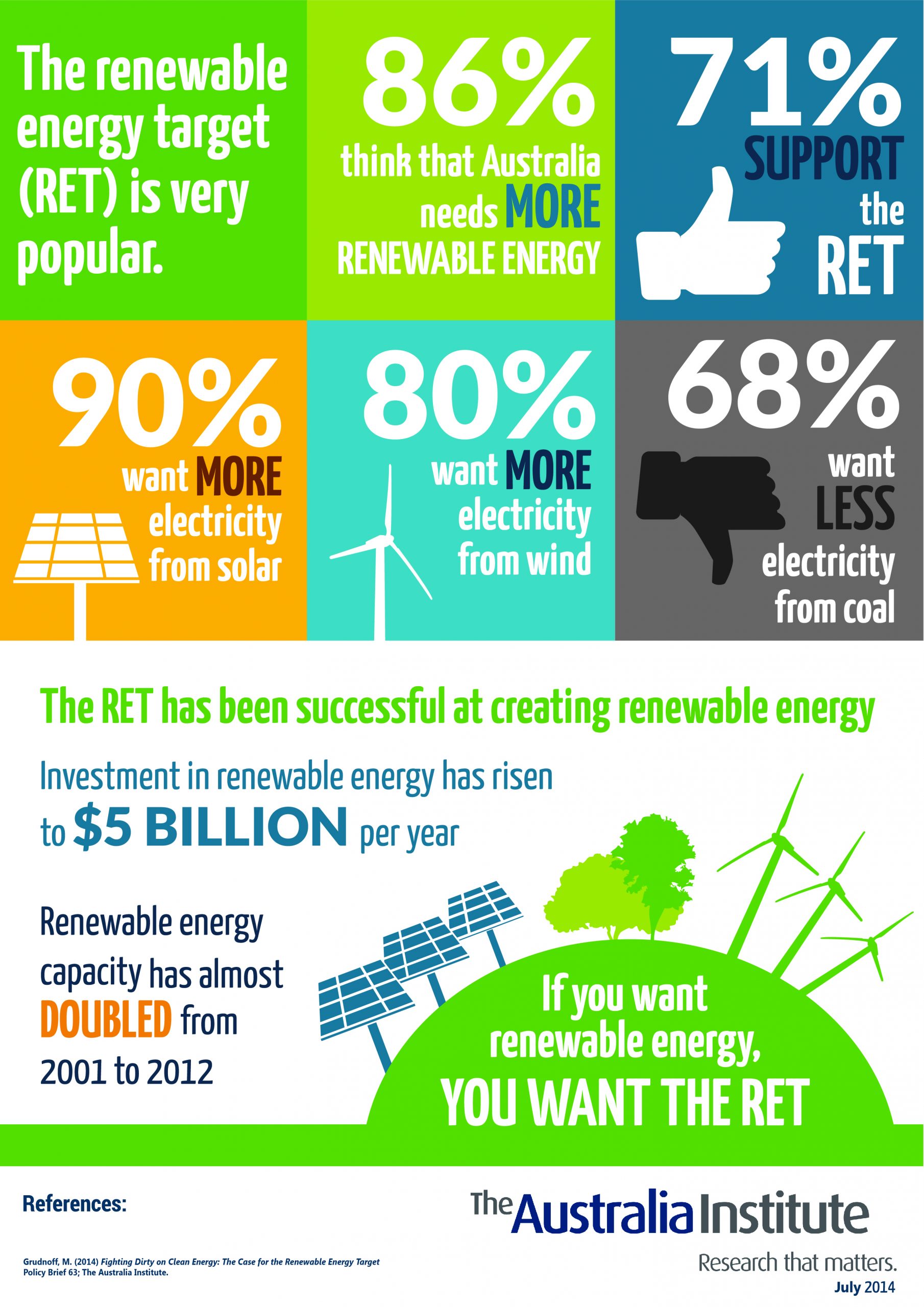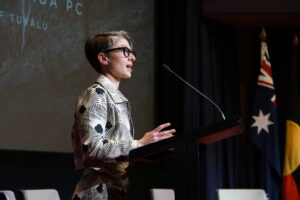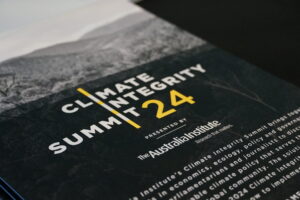Climate of change in the new Senate
- Fighting dirty on clean energy
- The price of inequality
- Playing minor chords to major effect
- RET-boy!
- TAI in the media
- Infographic
- Weekly updates from TAI
1. Fighting Dirty on Clean Energy
The big fossil fuel generators are keen to water down or scrap the Renewable Energy Target (RET). They’re the biggest losers from a policy that has doubled Australia’s renewable energy capacity. With demand for electricity falling and renewable energy increasing, fossil fuel producers find they are getting a smaller slice of a shrinking pie.
Intelligent Energy Systems (IES) has just done some modelling that shows who wins and who loses from scrapping the RET. It certainly sheds light on the fossil fuel lobby’s actions. If the RET was scrapped over the next 10 years, existing fossil fuel generators would get a windfall gain of $12.8 billion. That’s a lot of reasons to want the RET gone.
The biggest loser from scrapping the RET is not surprisingly the renewable energy sector which will lose $7.7 billion. What is less well known is that another big loser will be electricity consumers. We are set to lose $500 million over 10 years.
Electricity consumers lose out because the RET is putting downward pressure on wholesale electricity prices. If the RET is scrapped, those prices will rise and flow through to retail prices.
The electricity prices paid by you and I will be lower in the next few years because of the RET. Scrapping it will mean we pay more. No RET means higher power bills.
This is something that the fossil fuel lobby and the government aren’t keen for you to hear. Their campaign has involved telling people the RET is bad for consumers. The prime minister has claimed that the RET is driving up electricity prices ‘very significantly’.
The problem that the fossil fuel lobby has is that the RET has been too successful. It is transforming the way we generate electricity and that means a smaller role and less money for fossil fuel generators.
The other problem the fossil fuel lobby has is that the RET and renewable energy are very popular. In a survey done by the Australia Institute 86 per cent of respondents want to see more renewable energy and 79 per cent think governments should support an expansion of renewable energy. With 71 per cent support for the RET, it appears that Australian’s want the RET to lead that expansion.
There is also very strong support for more electricity generated from hydro (72 per cent), wind (80 per cent) and solar (90 per cent). By comparison, only 11 per cent wanted more electricity generated from coal. This shows the bind the fossil fuel lobby is in. People don’t want their product. They do want renewables.
What’s a big fossil fuel company with lots of political power to do?
2. The Price of inequality
On Tuesday 8 July Nobel prize winning economist Joe Stiglitz spoke at the Sydney Town Hall to a packed audience. His subject was The price of inequality, also the title of his latest book.
In his lecture, Stiglitz described how income inequality impacts on people’s quality of life; including life expectancy, access to education, chances for upward mobility and access to the political process. To Stiglitz’s mind, inequality in the political system is perhaps the most important. Without that there is little chance of other forms of inequality being addressed.
Stiglitz tailored his presentation to the Australian audience, presenting facts and figures showing that, while Australia is not yet as bad as the US, we are heading in the same direction.
Despite this, Stiglitz maintains that nothing is inevitable. That it is government policy which determines whether the distribution of income will worsen or improve. He singled out the proposed tax on visits to the doctor and other health providers as one policy that would increase the gap between rich and poor.
On the morning of his speech, The Australia Institute released our own paper on inequality, Income and wealth inequality in Australia. The findings include that the top 20 per cent of people have five times more income than the bottom 20 per cent, and hold 71 times more wealth. Perhaps the gap between those with the most and those with the least is most starkly highlighted by the fact that the richest seven individuals in Australia hold more wealth than 1.73 million households in the bottom 20 per cent.
Stiglitz highlighted the fact that the average wage in the US has not kept pace with growth in the economy but has been much the same in real terms over four decades. The minimum wage has fallen relative to both the average wage and cost of living. Effectively, the poor have become even poorer.
In Australia, the average wage has kept pace with economic growth. Minimum wages have fallen behind, as have Newstart payments. Newstart is indexed to the Consumer Price Index (CPI) which has resulted in an increasing income gap relative to the average. That gap continues to widen – an unemployed family of four has gone from about 10 per cent above the poverty line in 1991, to 20 per cent or more below the poverty line now.
The Abbott Government has announced it wants to change indexation arrangements (to CPI) for age and veteran pensions, among others, which would lead to them falling further and further behind. This clearly demonstrates the influence of government policy on inequality. Unfortunately there are a host of other examples in the 2014-15 Budget.
At the same time as cutting income support and services, the government has flagged tax cuts. As we know from past experience, tax cuts tend to go to the well-off, the corporate sector and the rich.
Income and wealth inequality in Australia documents these factors in more detail.
All this is policy and nothing is inevitable as Stiglitz reminds us. Stiglitz himself has set out a number of policy measures that governments should adopt in order to address inequality.
WATCH: City of Sydney has released video of the evening, which you can watch online here
3. Playing minor chords to major effect
The terms ‘minority government’ and ‘majority government’ are often used to describe governments that have respectively either no control, or complete control, over their policy and legislative agenda. In reality, the terms are virtually meaningless.
Government is formed in the House of Representatives (the lower house) when the party, or group of parties who agree to work together, have a majority of members. In the Australian commonwealth parliament that means 76 of the 150 seats.
The description of the major party, the Liberal Party (which polled 32.02 per cent first preference votes in the lower house at the 2013 Federal election) and the minor National Party (which polled 4.29 per cent) as ‘The Coalition’ rather than ‘a coalition’ speaks volumes. (It is further complicated of course by the merger of the two parties in Queensland as the LNP which received 8.92 per cent of the national vote).
Ironically, Tony Abbott went to the last election promising not to do deals with ‘minor parties’ when, in reality, he and his party had already done a deal to ensure that the leader of the National Party, a party which attracted fewer votes than the Palmer United Party, and less than half the votes of the Greens, would be the Deputy Prime Minister.
Soon after Abbott’s election as Prime Minister the minor National Party exerted major influence and forced Joe Hockey to do a back-flip on the foreign take-over of Graincorp. Tony Abbott may have declared Australia ‘open for business,’ but the National Party made it clear that they would determine our opening hours.
The minority ALP governments of Julia Gillard and Kevin Rudd held only 72 of the 150 lower house seats after the election. In turn, they took office on the basis of a coalition formed with three independents and a member of the Greens. Most commentators said it ‘would never work’ and that ‘unstable’ minority government would never be able to pass legislation.
It wasn’t ‘ironic’ that a minority government passed record numbers of bills through both Houses of Parliament, including the contentious National Disability Insurance Scheme (NDIS) and carbon price. On the contrary, the ability to pass so much legislation through both houses of Parliament flowed directly from the fact that the government had to consult with the Greens and independents before they introduced legislation. Having consulted and compromised in drafting the bills introduced to the lower house, the government never failed to pass a bill through the upper house that the Greens had supported in the lower house.
Majority governments have had a minority in the Senate for all but 3 of the last 30 years. History shows that a massive majority in the lower house does little to pressure the Senate into supporting legislation they don’t like. The final shape and timing of the GST, the sale of Telstra, industrial relations laws and the carbon price were all determined by the Senate.
Tony Abbott said he wouldn’t do deals with minor parties. Leaving aside the deals he has already done with the Nationals, he is now faced with the choice of breaking his promise to do no deals, or failing to deliver even parts of the policy promises he has already made. While the Senate is frustrating for prime ministers that is, of course, why the constitution put it there.
4. RET-boy
If you haven’t seen our animated action boy saving us from coal fired power, protecting windmills and trying to dodge Greg Hunt & Tony Abbott’s sceptic-led review, you’ve been missing out!
Watch him here on youtube
5. TAI in the media
Abolishing renewable energy target rewards rich polluters
Wealth of seven richest Australians exceeds that of 1.73 million households
Watch Matt Grudnoff launch Fighting dirty on clean energy on The Business
Palmer joins Hewson for a RET love-in
Australian banks face more pressure over support for coal projects
6. Infographic

Between the Lines Newsletter
The biggest stories and the best analysis from the team at the Australia Institute, delivered to your inbox every fortnight.
You might also like
Labor’s pledge to depoliticise the public service is undermined by the government only hearing what it wants to hear on climate change
While last year’s robodebt royal commission exposed a shocking lack of ethics among senior ranks of the Australian public service, the systemic condition still largely seems to be regarded as an aberration.
The Climate Crisis is an Integrity Crisis | Polly Hemming
I am starting my address to this year’s summit in the exact same way that I started last year’s address. Because it is just over a year since I delivered these same words, which aren’t actually my words. They are the words of our Climate Change Minister, and they provide a baseline of sorts for what progress has been made in that time.
Highlights from the Climate Integrity Summit 2024
2023 has shown us a planet on the brink of collapse. Cyclones, heatwaves, catastrophic floods, fires and landslides have killed people, destroyed ecosystems and decimated communities. And yet Australia is still yet to repair all the homes lost in the Black Summer bushfires of 2020 or the devastating Lismore floods of 2017 and 2022. No


